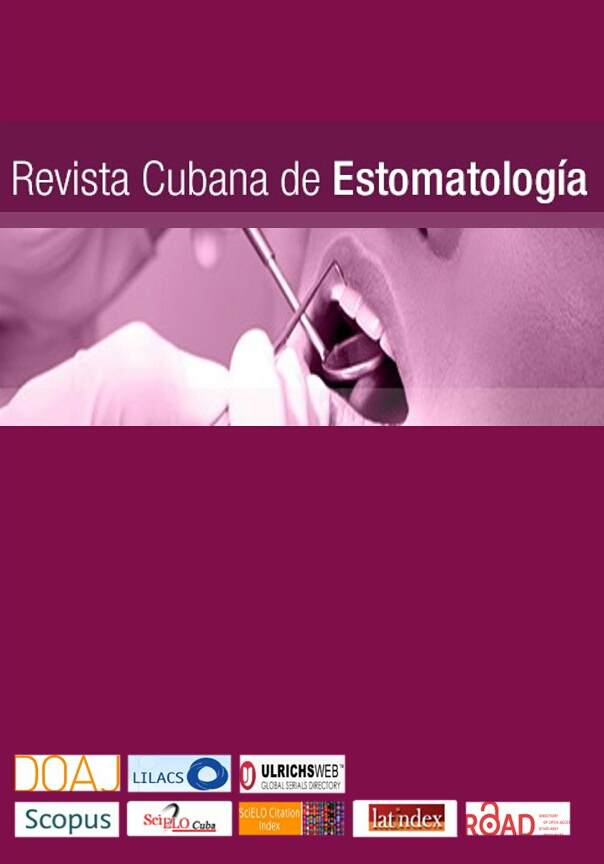Early diagnosis and treatment of Gorlin-Goltz syndrome: eight-year follow-up
Keywords:
Gorlin syndrome, basal cell carcinoma, odontogenic cysts.Abstract
Introduction: Gorlin-Goltz syndrome, also known as nevoid basal cell carcinoma syndrome, is an autosomal dominant inherited disorder of high level penetrance and variable expressiveness. In 1960 Gorlin and Goltz listed the disease cases previously reported in the literature, concluding that it was a triad syndrome (basal cell carcinomas, multiple odontogenic keratocysts and skeletal anomalies). It is now known that a broad spectrum of other systemic manifestations may be present, such as neurological, ophthalmic, genital, cardiovascular and endocrine.
Objective: Describe a clinical case of Gorlin-Goltz syndrome and its eight-year follow-up, and highlight the importance of the dentist in the early diagnosis and treatment of the syndrome.
Case report: A 10-year-old male patient attended the Oral and Maxillofacial Surgery Service of Santa Casa de Misericordia Hospital in Sao Felix, Bahia, Brazil, in February 2004, accompanied by his grandmother, who reported that her grandson's teeth "were crooked". Physical examination revealed an increase in the volume of the right side of the face, hypertelorism, broad nasal base, frontal bossing, mild mandibular prognathism and shortened toes, whereas oral examination found ill-positioned teeth and midline deviation. The patient was followed up for eight years, and during this time imaging tests were performed which showed large areas of recurrent radiolucent lesions. Diagnosis of odontogenic keratocyst was verified by histopathological examination, confirming the diagnostic hypothesis of Gorlin-Goltz syndrome. The patient was referred for genetic evaluation and is currently being followed up at the State University of Feira de Santana, Bahia.
Conclusions: Multidisciplinary long-term follow-up is essential in cases of this syndrome to improve the quality of life of patients.
Downloads
References
Méndez ER, Fuentes JMG. Síndrome de Gorlin-Goltz: revisión bibliográfica y presentación de una serie de casos clínicos de una familia de siete integrantes. Rev Mex Cir Bucal Max. 2015;11(6):17-9.
Coutinho FA, Fonseca LS, Fernandes A, Pinheiro J, Malheiro R. Tumores odontogénicos queratoquísticos múltiplos em Síndrome de Gorlin-Goltz. Rev Port Estomatol Cir Maxilofac. 2016;57(1):4.
Drumond JPN, Allegro BB, Sendyk WR, Oliveira FMM. Síndrome de Gorlin-Goltz: diagnóstico de um caso associado ? cardiopatia e diabetes mellitus 2. RBCP. 2016;31(4):578-82.
Abreu JM, Gouveia MP, Ferreira CT, Brinca A, Vieira R. Síndrome de Gorlin-Goltz: diagnóstico e hipóteses de tratamento. Revista Científica da Ordem dos Médicos. 2017;30(5):418-21.
Figueirêdo Júnior EC, Pereira MSV, Barsi Filho HCC, Ferreira JM, Xavier MA, Gomes DQC, et al. Invasive basal cell carcinoma: A case report. Archives of Health Investigation. 2018;7(3):112-4.
Gameiro A, Gouveia M, Brinca A, Brites MM, Vieira R, Figueiredo A. Vismodegib no Tratamento do Carcinoma Basocelular Avançado – Experiência de 3 Casos. SPDV. 2016;74(1):83-7.
Nogueira HSH, Costa JV, Neris CWD, Nogueira TH, Neris CKD. Tumor odontogênico queratocístico: revisão de literatura. UNINGÁ Review. 2015;24(2):67-71.
Dall'Magro AK, Ottoni R, Lauxen J, Santos R, Valcanaia TC, Ávila VJB, et al. Síndrome de Gorlin-Goltz – relato de casos. RFO-UPF. 2014;19(2):239-44.
Domingues S, Pereira S, Machado A, Bezerra R, Figueira F, Cunha B, et al. Síndrome de Gorlin-Goltz: caso clínico. Nascer e Crescer. 2014;23(2):87-91.
Di Nisio L, Pais ME, Englebert F, Farinaz C, Fernández L, Eichel AB, et al. Síndrome de Gorlin-Goltz. Oftalmología Clínica y Experimental. 2016;9(1):19-24.
Martins JN. Síndrome de Gorlin Goltz e suas implicações odontológicas. Rev Ciênc Méd. 2015;24(3):113-9.
Oliveira LNB, Tolstoy F, Lobão D. Síndrome de Gorlin Goltz: relato de um caso exuberante. Surgical & Cosmetic Dermatology. 2014;6(3):289-92.
Nilesh K, Tewary S, Zope S, Patel J, Vande A. Dental, dermatological and radiographic findings in a case of Gorlin-Goltz Syndrome: report and review. PAMJ. 2017;27(1):96.
Peralta FS, Quadros JG, Magnabosco Neto AE, Araujo KL, Scherma AP. Tumor odontogênico ceratocístico: relato de caso clínico. ClipeOdonto-UNITAU. 2016;8(2):51-7.
Figueira JA, Batista FRS, Rosso K, Veltrini VC, Pavan AJ. Delayed Diagnosis of Gorlin–Goltz Syndrome: The Importance of the Multidisciplinary Approach. J Craniofac Surg. 2018 Sep;29(6):e530-e531. doi: 10.1097/SCS.0000000000004438
Published
How to Cite
Issue
Section
License
Authors retain all rights to their works, which they can reproduce and distribute as long as they cite the primary source of publication.
The Rev Cubana Estomatol is subject to the Creative Commons Attribution-Non-Commercial 4.0 International License (CC BY-NC 4.0) and follows the publication model of SciELO Publishing Schema (SciELO PS) for publication in XML format.
You are free to:
- Share — copy and redistribute the material in any medium or format.
- Adapt — remix, transform, and build upon the material.
The licensor cannot revoke these freedoms as long as you follow the license terms.
Under the following terms:
Attribution — You must give appropriate credit, provide a link to the license, and indicate if changes were made. You may do so in any reasonable manner, but not in any way that suggests the licensor endorses you or your use.
- NonCommercial — You may not use the material for commercial purposes.
No additional restrictions — You may not apply legal terms or technological measures that legally restrict others from doing anything the license permits.
Notices:
- You do not have to comply with the license for elements of the material in the public domain or where your use is permitted by an applicable exception or limitation.
- No warranties are given. The license may not give you all of the permissions necessary for your intended use. For example, other rights such as publicity, privacy, or moral rights may limit how you use the material.


